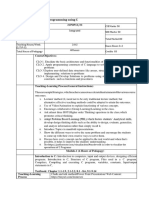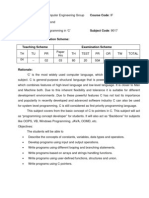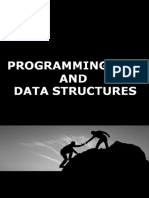0 ratings0% found this document useful (0 votes)
33 viewsProblem Solving Thru Programming
The document outlines a course on problem solving through programming. It details course objectives, modules, pedagogy, outcomes and assessment. The course aims to teach programming constructs of C language to solve real-world problems and design modular solutions using data structures, functions and pointers.
Uploaded by
raju gtCopyright
© © All Rights Reserved
We take content rights seriously. If you suspect this is your content, claim it here.
Available Formats
Download as DOCX, PDF, TXT or read online on Scribd
0 ratings0% found this document useful (0 votes)
33 viewsProblem Solving Thru Programming
The document outlines a course on problem solving through programming. It details course objectives, modules, pedagogy, outcomes and assessment. The course aims to teach programming constructs of C language to solve real-world problems and design modular solutions using data structures, functions and pointers.
Uploaded by
raju gtCopyright
© © All Rights Reserved
We take content rights seriously. If you suspect this is your content, claim it here.
Available Formats
Download as DOCX, PDF, TXT or read online on Scribd
You are on page 1/ 2
PROBLEM SOLVING THROUGH PROGRAMMING
Course Code 21PSP14 CIE Marks 50
Teaching Hours/Week (L:T:P: S) 2:2:0:0 SEE Marks 50
Total Hours of Pedagogy 40 Total Marks 100
Credits 03 Exam Hours 03
Course Objectives:
1. Elucidate the basic architecture and functionalities of a Computer
2. Apply programming constructs of C language to solve the real world problems
3. Explore user-defined data structures like arrays, structures and pointers in implementing
solutions to problems
4. Design and Develop Solutions to problems using modular programming constructs such as
functions and procedures
Pedagogy (General Instructions)
These are sample Strategies, which teacher can use to accelerate the attainment of the various course
outcomes.
1. Lecturer method (L) need not to be only traditional lecture method, but alternative effective
teaching methods could be adopted to attain the outcomes.
2. Use of Video/Animation to explain functioning of various concepts.
3. Encourage collaborative (Group Learning) Learning in the class.
4. Ask at least three HOT (Higher order Thinking) questions in the class, which promotes critical
thinking.
5. Adopt Problem Based Learning (PBL), which fosters students’ Analytical skills, develop design
thinking skills such as the ability to design, evaluate, generalize, and analyse information
rather than simply recall it.
6. Introduce Topics in manifold representations.
7. Show the different ways to solve the same problem and encourage the students to come up
with their own creative ways to solve them.
8. Discuss how every concept can be applied to the real world - and when that's possible, it helps
improve the students' understanding.
Module-1
Introduction to Computer Hardware and Software: Computer generations, computer types, bits,
bytes and words, CPU, Primary memory, Secondary memory, ports and connections, input devices,
output devices, Computers in a network, Network hardware, Software basics, software types.
Overview of C: Basic structure of C program, executing a C program. Constant, variable and data types,
Operators and expressions
Pedagogy: Active Learning
Module-2
Managing Input and output operations. Conditional Branching and Loops. Example programs, finding
roots of a quadratic equation, computation of binomial coefficients, plotting of Pascal’s triangle.
Pedagogy: Active Learning, Problem based learning
Module-3
Arrays: Arrays (1-D, 2-D), Character arrays and Strings, Basic Algorithms: Searching and Sorting
Algorithms (Linear search, Binary search, Bubble sort and Selection sort).
Pedagogy: MOOC, Active Learning
Module-4
User Defined Functions and Recursion.
Example programs: Finding Factorial of a positive integer, GCD of two numbers and Fibonacci
sequence.
Pedagogy: Problem based learning
Module-5
Structures, Unions and Pointers, Pre-processor Directives and Example Programs
Pedagogy: MOOC
Course Outcomes (Course Skill Set)
At the end of the course the student will be able to:
1. Recognize the hardware parts and software types in a computer.
2. Elucidate the basic architecture and functionalities of a Computer
3. Apply programming constructs of C language to solve the real world problems
4. Identify and correct the syntax and logical errors in C programs.
5. Explore user-defined data structures like arrays, structures and pointers in implementing
solutions to problems like searching and sorting
6. Design and Develop Solutions to problems using modular programming constructs such as
functions and procedures
Assessment Details (both CIE and SEE)
The weightage of Continuous Internal Evaluation (CIE) is 50% and for Semester End Exam (SEE) is
50%. The student has to obtain minimum of 40% marks individually both in CIE and SEE to pass.
Theory Semester End Exam (SEE) is conducted for 100 marks (3 Hours duration). Based on this
grading will be awarded.
Continuous Internal Evaluation:
1. Methods recommended: Three Test (60%), Written Quiz (20%) and module assignments
(20%).
2. The class teacher has to decide the topic for closed book test and Written Quiz. In the
beginning only teacher has to announce the methods of CIE for the subject.
Semester End Examination:
Theory SEE will be conducted by University as per scheduled time table, with common question papers
for subject
1. The question paper will have ten questions. Each question is set for 20 marks.
2. There will be 2 questions from each module. Each of the two questions under a module (with a
maximum of 3 sub questions), should have a mix of topics under that module.
3. The students have to answer 5 full questions, selecting one full question from each module
Suggested Learning Resources:
Books
1. E. Balaguruswamy, Programming in ANSI C, 7th Edition, Tata McGraw-Hill
2. Brian W. Kernighan and Dennis M. Ritchie, The ‘C’ Programming Language, Prentice Hall of
India.
Web links and Video Lectures (e-Resources):
1. elearning.vtu.ac.in/econtent/courses/video/BS/15PCD23.html
2. https://nptel.ac.in/courses/106/105/106105171/
Activity Based Learning (Suggested Activities in Class)/ Practical Based learning
1. Real world problem solving using group discussion. E.g., Electricity bill generation. etc.,
2. Demonstration of solution to a problem through programming.
You might also like
- Cse Programming For Problem Solving Lecture NotesNo ratings yetCse Programming For Problem Solving Lecture Notes185 pages
- Andhra Pradesh State Council of Higher EducationNo ratings yetAndhra Pradesh State Council of Higher Education32 pages
- Programming For Problem Solving Theory and LabNo ratings yetProgramming For Problem Solving Theory and Lab5 pages
- CSE 115 - 115L Course Objective and OutcomeNo ratings yetCSE 115 - 115L Course Objective and Outcome6 pages
- Syllabus of Second Year B.E. Computer Engg.No ratings yetSyllabus of Second Year B.E. Computer Engg.35 pages
- ESCO5 Lecture plan even 23 24_3223_ESCO5_10-04-2024No ratings yetESCO5 Lecture plan even 23 24_3223_ESCO5_10-04-20244 pages
- 707247246_CS-114,Fundamentals of Computer ProgrammingNo ratings yet707247246_CS-114,Fundamentals of Computer Programming3 pages
- PSC - Course Handout - CS1002 - August 2023No ratings yetPSC - Course Handout - CS1002 - August 20238 pages
- Manipal University Jaipur: Object Orient C Programming - CA 1103 - 4 Credits - 3 1 0 4No ratings yetManipal University Jaipur: Object Orient C Programming - CA 1103 - 4 Credits - 3 1 0 47 pages
- Problem Solving and Programming With C 12 September 2021 With Lab ExercisesNo ratings yetProblem Solving and Programming With C 12 September 2021 With Lab Exercises6 pages
- Basic Programming and Data Structure (C)No ratings yetBasic Programming and Data Structure (C)8 pages
- B.Tech syllabus from 20.10.23 (1st Year) copyNo ratings yetB.Tech syllabus from 20.10.23 (1st Year) copy38 pages
- M3-R4 Programming and Problem Solving Through C PDFNo ratings yetM3-R4 Programming and Problem Solving Through C PDF16 pages
- 24CS203ES101 - Problem Solving Using C Programming - B. Vijay Kumar - Course PlanNo ratings yet24CS203ES101 - Problem Solving Using C Programming - B. Vijay Kumar - Course Plan15 pages
- PROGRAMMING FOR PROBLEM SOLVING USING C SyllabusNo ratings yetPROGRAMMING FOR PROBLEM SOLVING USING C Syllabus2 pages
- NEP-B.Sc. (Computer Science) - Sem. I & II - (Syllabus)No ratings yetNEP-B.Sc. (Computer Science) - Sem. I & II - (Syllabus)17 pages
- Discrete Mathematical Structures 15CS36: Course Objectives: This Course Will Enable Students ToNo ratings yetDiscrete Mathematical Structures 15CS36: Course Objectives: This Course Will Enable Students To53 pages






























































